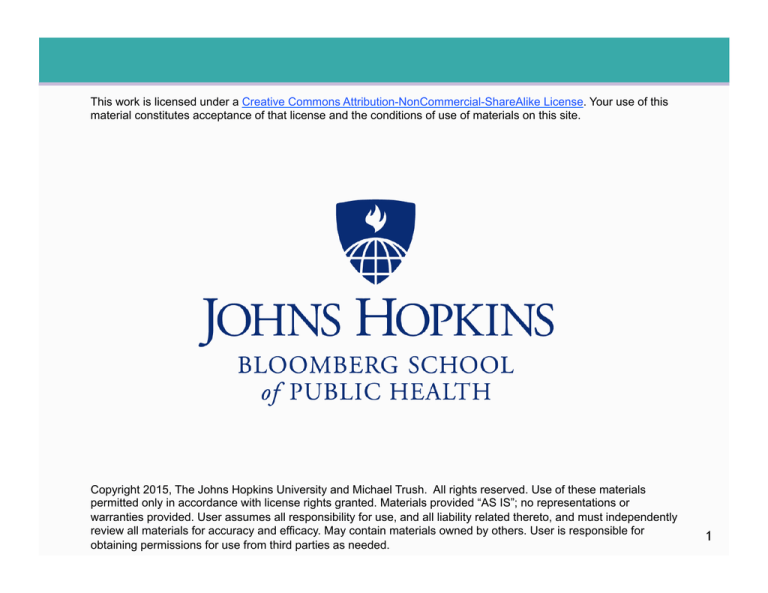
This work is licensed under a Creative Commons Attribution-NonCommercial-ShareAlike License. Your use of this
material constitutes acceptance of that license and the conditions of use of materials on this site.
Copyright 2015, The Johns Hopkins University and Michael Trush. All rights reserved. Use of these materials
permitted only in accordance with license rights granted. Materials provided “AS IS”; no representations or
warranties provided. User assumes all responsibility for use, and all liability related thereto, and must independently
review all materials for accuracy and efficacy. May contain materials owned by others. User is responsible for
obtaining permissions for use from third parties as needed.
1
Neurotoxicology
Joseph P. Bressler, PhD
Johns Hopkins University
Toxicants/Toxins Target
! http://outreach.mcb.harvard.edu/animations.htm
! The “Teacher Animations” link under the Neurobiology heading on
the right-hand side of the page linked to the above URL has four
animations
- View “Action Potential” and “Synaptic Activity”
3
Section A
Background
The material in this video is subject to the copyright of the owners of the material and is being provided for educational purposes under
rules of fair use for registered students in this course only. No additional copies of the copyrighted work may be made or distributed.
What Is Neurotoxicity?
! Adverse change in the structure or function of the central or
peripheral nervous systems
! Organization for Economic Co-operation and Development (OECD)
defines neurotoxicity as “an adverse change in morphology,
physiology, growth, development, or lifespan of an organism that
results in an impairment of functional capacity, an impairment of
the capacity to compensate for additional stress, or an increase in
susceptibility to other environmental influences”
5
Neurotoxicology in Public Health
! Neurotoxicology helps us to ...
- Identify new chemicals (environmental and commercial) that
have the potential to harm the nervous system (chemical
testing)
- Identify chemicals already in the environment that harm the
nervous system (epidemiology)
- Understand mechanisms underlying the harm caused by these
chemicals, identify new chemicals
6
Examples of Neurotoxicants
! Inorganic and organic metals, lead (Pb)—Pb2+ encephalopathy,
cognitive development; mercury (Hg)—vision and speech,
coordination, cognitive; manganese (Mn)—motor syndrome similar,
but different from Parkinson’s
! Persistent organic pollutants (polychlorinated biphenyls,
polybrominated biphenyl ethers)—cognitive
! Organic solvents (methyl n-butyl ketone)—peripheral neuropathy
! Herbicides (Paraquat, rotenone)—Parkinson’s disease
! Organophosphate insecticides—cognitive
! Fungus contamination of grain produces toxin—hypoxia
7
Human Mental Function Domains
! Motor-movement—coordination (balance)
! Cognitive—the global capacity of a person to act purposefully, to
think rationally, and to deal effectively with his environment
! Executive—“actions we perform to ourselves and direct at ourselves
so as to accomplish self-control, goal-directed behavior, and the
maximization of future outcomes”
! Senses-tactile—smell, auditory, vision
8
Measuring Functional Domains
! Behavioral
- Cognitive
Humans: Stanford-Binet, Wechsler—questions focus on
things not taught in school, such as attention, memory,
and problem-solving skills
! Rodent: Morris Water Maze
Motor (developmental milestones)
! - ! ! ! Gross motor: using large groups of muscles to sit, stand,
walk, run, etc., keeping balance, and changing positions
Fine motor: using hands to be able to eat, draw, dress,
play, write, and do many other things
Rodent: rotarod performance test
- Electrophysiological: measure current conductance
9
Why Nervous System Is Uniquely Sensitive to Chemicals
! One neuron could be more than one foot long
- Macromolecules/nutrients must travel from the cell body to
dendrites (end of the cell)
! Brain uses one-third required energy but has little capacity to store
glycogen
! Most neurons are postmitotic and will not be replaced
10
Case Study: Lead (Pb) Poisoning
11
Lead Poisoning—Acute to Chronic
12
High Lead Increases Blood Brain Barrier Permeability
Evans Blue Dye is permeable
throughout organism ...
... The barrier is
much more
permeable when
high amounts of Pb
are consumed.
... except the
brain, due to the
blood brain
barrier. ...
Control
2 percent in food
4 percent in food
13
Pb-Induced Hemorrhagic Encephalopathy
Lead
Control
14
Can You Guess the Child with Lower Levels of Lead Exposure?
! But you can choose the children with poor neurodevelopment
15
Blood Lead Levels and Cognitive Development
! Inverse relationship between blood lead and cognitive development
! Most of the damage
experienced by children with
higher lead levels actually is
due largely to the initial IQ loss
at blood lead concentrations of
10 µg/dL or less
16
Decline Greatest In High Socioeconomic Group
17
Eliminating Lead Poisoning
! Needleman (University of
Pittsburgh) found that lead
levels in children’s teeth are
associated with lower IQ,
shortened attention spans, and
delayed language skills.
Deficits persisted, resulting in
learning disabilities and school
failure.
! Julian Chisolm (KennedyKrieger Institute) found a new
treatment regimen for lead
encephalopathy, used blood
tests to identify lead levels,
and pioneered lead abatement
18





